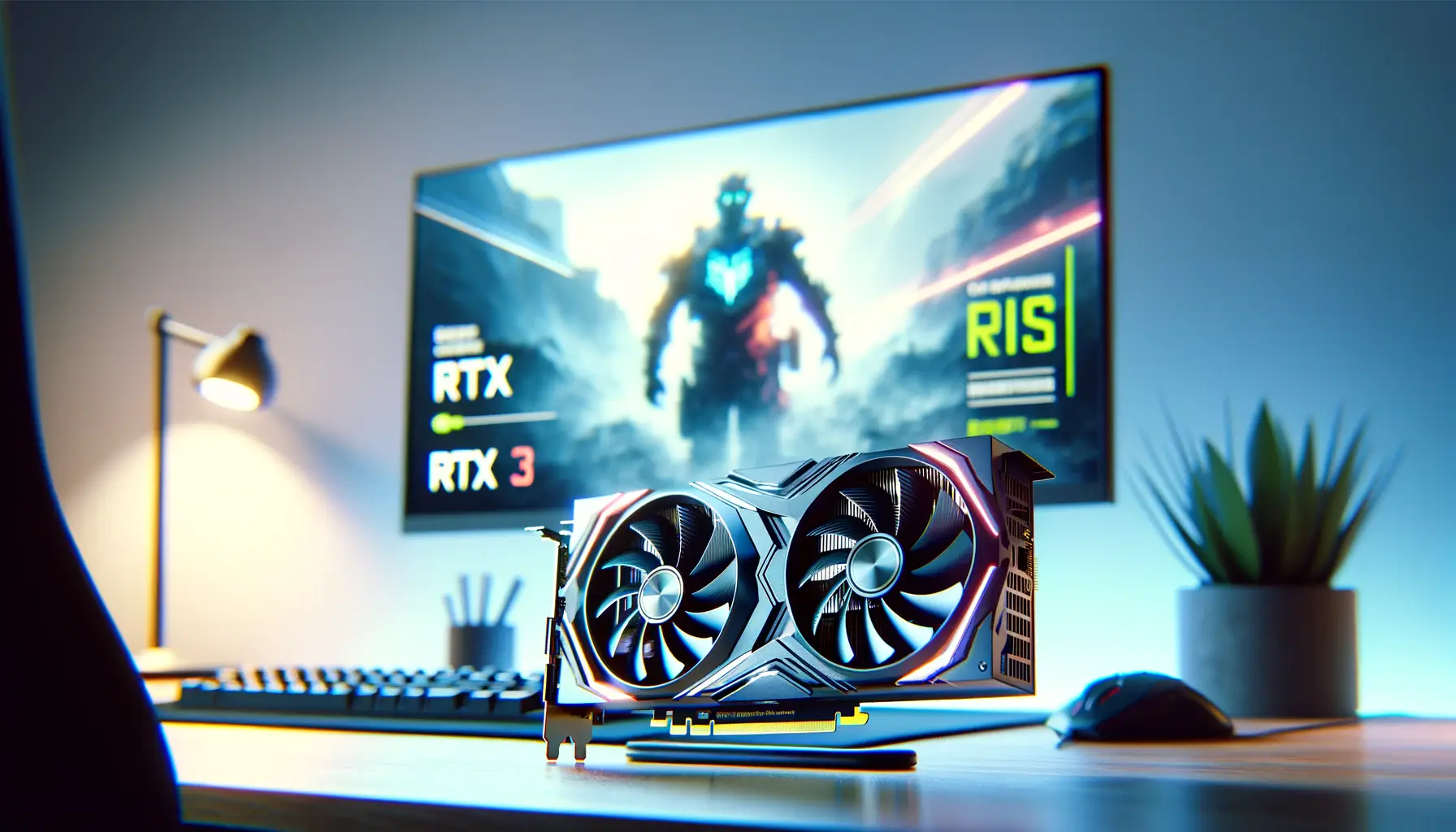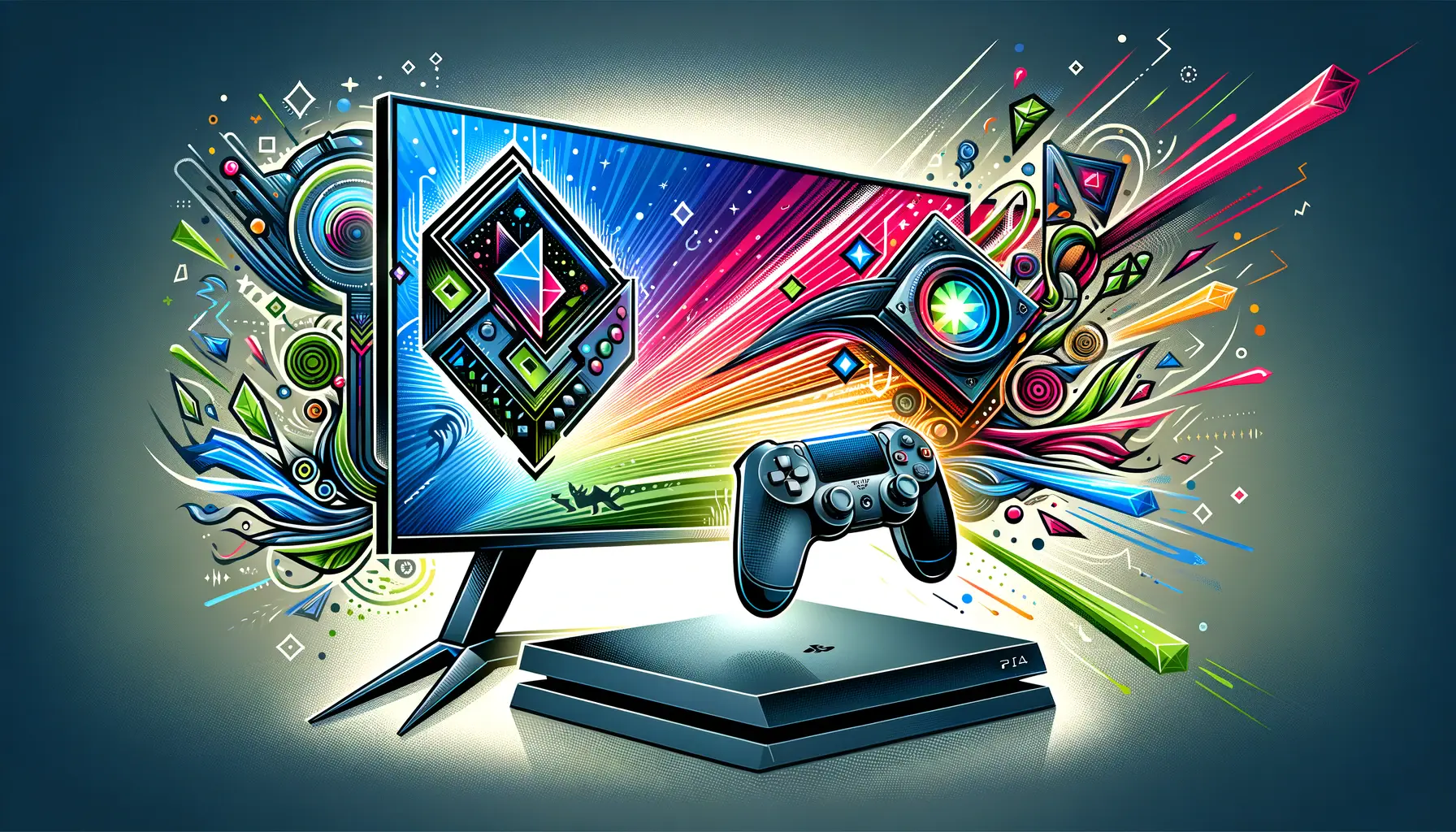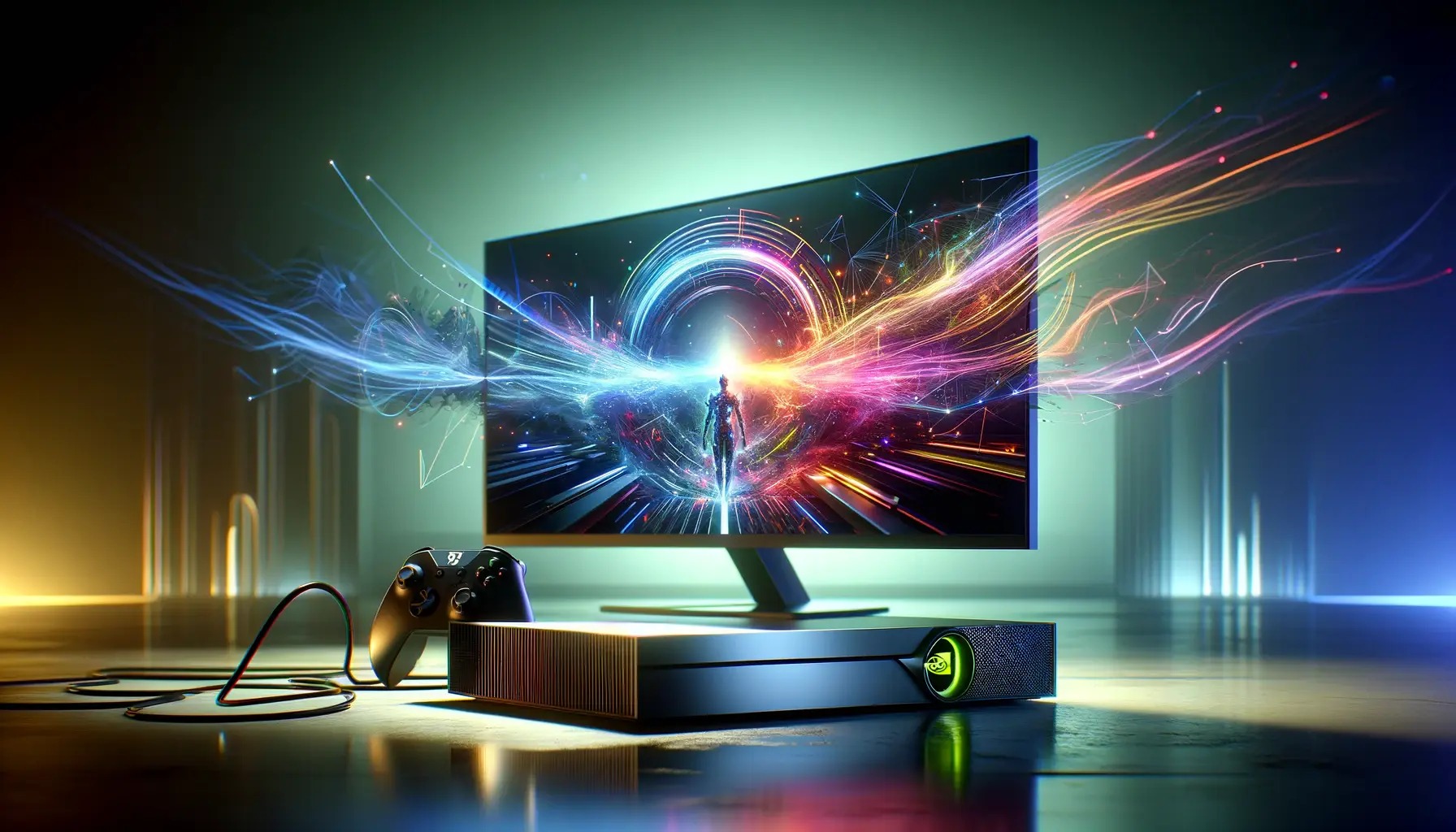The realm of competitive gaming is a battlefield not just for players but also for the technology that powers their victories and defeats.
In this high-stakes world, every frame, every pixel, and every millisecond counts, making the quest for superior hardware and software solutions a never-ending pursuit.
NVIDIA’s Deep Learning Super Sampling (DLSS) technology has been at the forefront of this quest, offering gamers a significant boost in performance and visual fidelity.
With the introduction of DLSS 3, NVIDIA aims to set a new benchmark for gaming excellence, promising upgrades that could redefine competitive gaming as we know it.
DLSS 3, the latest iteration of NVIDIA’s groundbreaking AI-driven rendering technology, promises to bring about a revolution in the way games are played and experienced.
By leveraging advanced deep learning algorithms, DLSS 3 enhances graphics performance without compromising on quality, allowing for smoother and more immersive gameplay.
This technology is not just an incremental upgrade; it represents a significant leap forward, offering features and improvements that cater specifically to the needs of competitive gamers.
The focus on upgrades within DLSS 3 underscores NVIDIA’s commitment to pushing the boundaries of gaming technology, ensuring that players have the tools they need to excel in their digital arenas.
- Understanding DLSS Technology
- The Impact of DLSS 3 on Game Developers
- DLSS 3 and eSports: A Game Changer
- Comparing DLSS 3 with Previous Versions
- Optimizing Your Setup for DLSS 3
- DLSS 3 in Action: Real-World Applications
- Exploring the Future of Gaming with DLSS 3
- Embracing the Future: The Role of DLSS 3 in Shaping Next-Gen Gaming
- DLSS 3 Upgrades for Competitive Gaming: FAQs
Understanding DLSS Technology
At the heart of DLSS (Deep Learning Super Sampling) technology lies a sophisticated AI-driven process that intelligently upscales lower-resolution images in real-time.
This allows games to run at higher frame rates, providing a smoother and more responsive gaming experience without sacrificing visual quality.
DLSS achieves this by utilizing dedicated Tensor Cores found in NVIDIA’s RTX series GPUs, which are specifically designed to handle deep learning and AI tasks efficiently.
The evolution of DLSS technology has been a journey of continuous improvement, with each version bringing enhancements that further blur the line between performance and image quality.
DLSS 3, in particular, introduces a game-changing feature known as Frame Generation.
This new capability works by interpolating frames, effectively doubling the frame rate in supported games.
For competitive gamers, where reaction times and fluid motion are paramount, this upgrade can significantly impact their performance and competitiveness.
Benefits of DLSS for Competitive Gaming
For the competitive gaming community, DLSS technology offers several key advantages.
Firstly, the increase in frame rates ensures that action sequences are smoother, reducing motion blur and making it easier to track fast-moving objects.
This is crucial in fast-paced games where split-second decisions can determine victory or defeat.
Additionally, by maintaining high visual fidelity while boosting performance, players no longer have to compromise on graphical settings to achieve a competitive edge.
This means that even in the most graphically demanding scenarios, gamers can enjoy crisp, clear visuals alongside high frame rates.
Another significant benefit of DLSS is its ability to reduce the strain on system resources.
By enabling games to run more efficiently, players with a wide range of hardware configurations can experience enhanced performance.
This democratization of high-quality gaming ensures that a larger segment of the gaming community can enjoy competitive gaming at its best, without the need for constant hardware upgrades.
DLSS technology, especially with the introduction of DLSS 3, stands as a testament to NVIDIA’s commitment to enhancing the competitive gaming landscape. By offering upgrades that significantly improve performance and visual quality, DLSS 3 is poised to become an essential tool for gamers looking to gain a competitive advantage.
The Impact of DLSS 3 on Game Developers
The advent of DLSS 3 not only benefits players but also opens new horizons for game developers.
This technology provides developers with the tools to push the boundaries of what’s possible in game design, enabling them to create more detailed and immersive gaming environments without worrying about performance penalties.
The impact of DLSS 3 on game development can be observed in several key areas.
Enhanced Creative Freedom
With DLSS 3, developers can incorporate higher-quality textures, more complex models, and advanced lighting effects, knowing that the technology will help maintain smooth gameplay.
This enhanced creative freedom allows for the creation of visually stunning games that can run efficiently on a wider range of hardware.
Developers can focus on bringing their artistic visions to life, secure in the knowledge that DLSS 3 will handle the performance aspects.
Furthermore, the ability to maintain high frame rates while delivering top-notch graphics quality means that developers can design games that are not only beautiful but also highly responsive.
This is particularly important for genres where precision and reaction time are crucial, such as first-person shooters or racing games.
Broader Accessibility
- Wider Audience Reach: By optimizing performance across various hardware configurations, DLSS 3 helps games reach a broader audience. Players with older or less powerful systems can enjoy the latest titles at acceptable frame rates, expanding the potential market for developers.
- Reduced Hardware Requirements: DLSS 3’s efficiency reduces the need for high-end hardware to run games at their best. This makes gaming more accessible to casual players who might not have the latest gaming rigs, thereby increasing the game’s appeal.
Streamlined Development Process
DLSS 3 also streamlines the game development process.
By integrating DLSS technology, developers can optimize their games for performance more easily, reducing the time and resources required for performance testing and optimization.
This efficiency can lead to shorter development cycles, allowing developers to focus on content creation and innovation.
The support and resources provided by NVIDIA for DLSS integration further aid developers in implementing this technology.
NVIDIA offers extensive documentation, SDKs, and direct support to ensure that integrating DLSS into games is as seamless as possible.
This support system is invaluable for developers looking to leverage DLSS technology to its fullest potential.
The integration of DLSS 3 represents a significant advancement in game development, offering a blend of high performance, stunning visuals, and broad accessibility. As developers continue to explore the possibilities enabled by DLSS 3, the future of gaming looks brighter and more inclusive than ever.
DLSS 3 and eSports: A Game Changer
The intersection of DLSS 3 technology and eSports represents a pivotal moment for competitive gaming.
eSports, characterized by its intense competition, large audiences, and substantial stakes, demands the highest standards of performance and visual clarity.
DLSS 3’s capabilities align perfectly with these requirements, offering enhancements that could significantly influence the eSports landscape.
Improving Player Performance
DLSS 3’s impact on player performance in eSports cannot be overstated.
By doubling frame rates without sacrificing image quality, players gain a smoother, more responsive gaming experience.
This improvement is crucial in competitive gaming, where reaction times and precision are paramount.
Higher frame rates lead to reduced input lag, allowing players to react more quickly to in-game events, a critical advantage in fast-paced competitive environments.
Moreover, the visual clarity preserved by DLSS 3 ensures that players can discern fine details even in chaotic scenes, helping them make better-informed decisions during matches.
This combination of smooth performance and sharp visuals equips players with the tools they need to perform at their best.
Standardizing Competitive Play
- Leveling the Playing Field: DLSS 3 helps standardize performance across different hardware setups, ensuring that all players have a fair chance to compete. This standardization is vital for the integrity of competitive eSports, where hardware disparities should not influence the outcome of matches.
- Enhancing Spectator Experience: The improvements in visual quality and frame rate also benefit spectators, providing them with a smoother and more engaging viewing experience. As eSports continues to grow as a spectator sport, the importance of delivering high-quality broadcasts cannot be underestimated.
Future of eSports Tournaments
The adoption of DLSS 3 technology by eSports tournaments could lead to a new standard in competitive gaming, where high frame rates and impeccable visual quality are the norm.
This shift would not only enhance the competitive experience for players but also make eSports more appealing to a wider audience.
As tournaments begin to embrace DLSS 3, we may see a significant evolution in how competitive gaming is presented and consumed.
Furthermore, the ability of DLSS 3 to run games efficiently on a variety of hardware makes it easier for tournament organizers to set up and manage events.
This efficiency could lead to more frequent and diverse competitions, contributing to the growth and dynamism of the eSports ecosystem.
DLSS 3 stands as a transformative technology for eSports, offering the potential to elevate player performance, standardize competitive conditions, and enhance the spectator experience. As this technology becomes more widely adopted, its impact on the competitive gaming world will likely be profound and far-reaching.
Comparing DLSS 3 with Previous Versions
The evolution of NVIDIA’s DLSS technology has been marked by significant milestones, each version introducing new features and improvements over its predecessors.
DLSS 3 is the latest chapter in this ongoing story of innovation, offering competitive gamers and enthusiasts unprecedented performance gains.
Understanding the advancements made from earlier versions to DLSS 3 provides insight into the technology’s rapid development and its impact on gaming.
DLSS 1.0 to DLSS 2.0: The Leap in Quality
DLSS 1.0 marked NVIDIA’s initial foray into AI-driven super sampling, promising improved performance with minimal loss in image quality.
However, it faced criticism for its sometimes blurry images and limited game support.
The introduction of DLSS 2.0 addressed these issues head-on, featuring a complete overhaul of the AI model.
This version offered significantly better image quality, greater flexibility in its application, and support for a wider range of games and resolutions.
DLSS 2.0 was a major step forward, providing gamers with a more balanced trade-off between performance and visual fidelity.
DLSS 2.0’s success laid the groundwork for further innovation, proving the viability of AI-driven rendering in mainstream gaming.
It demonstrated that with the right approach, it was possible to achieve both high performance and high-quality visuals, a balance that had previously been challenging to attain.
DLSS 3.0: Revolutionizing Performance with Frame Generation
- Frame Generation Technology: The most groundbreaking feature of DLSS 3 is its Frame Generation technology. Unlike its predecessors, DLSS 3 can interpolate frames, effectively doubling the frame rate in supported titles. This innovation is particularly beneficial for competitive gaming, where higher frame rates can significantly enhance player performance.
- Improved AI Algorithms: DLSS 3 also benefits from advancements in NVIDIA’s AI algorithms, offering even better image quality and performance optimization. These improvements ensure that games not only run smoother but also look better, pushing the boundaries of what’s possible in real-time rendering.
Impact on Gaming and Beyond
The transition from DLSS 1.0 through 2.0 to DLSS 3 represents a trajectory of continuous improvement and innovation.
Each version has expanded the possibilities of gaming, allowing for more detailed, expansive, and immersive game worlds without compromising on performance.
DLSS 3, with its Frame Generation and enhanced AI algorithms, stands as a testament to NVIDIA’s commitment to revolutionizing gaming technology.
Moreover, the implications of DLSS technology extend beyond gaming, with potential applications in professional visualization, virtual reality, and AI-driven content creation.
As DLSS continues to evolve, its impact is likely to be felt across a broad spectrum of industries and applications.
The journey from DLSS 1.0 to DLSS 3 highlights NVIDIA’s relentless pursuit of innovation, with each version bringing us closer to the ideal of flawless performance and visual fidelity. As DLSS technology continues to evolve, its role in shaping the future of gaming and digital experiences remains undeniably significant.
Optimizing Your Setup for DLSS 3
Embracing DLSS 3 technology can transform your gaming experience, offering a blend of high performance and stunning visual quality.
However, to fully benefit from what DLSS 3 has to offer, it’s essential to optimize your gaming setup accordingly.
This involves not just hardware considerations but also software adjustments to ensure that you’re getting the best possible experience.
Hardware Requirements and Recommendations
At the core of DLSS 3’s requirements is a compatible NVIDIA RTX GPU.
Since DLSS 3 utilizes the dedicated Tensor Cores and AI capabilities of these GPUs, having a supported model is non-negotiable.
For the best experience, investing in the latest generation of RTX cards is advisable, as they offer the most advanced Tensor Cores and the highest performance gains with DLSS 3.
Beyond the GPU, ensuring that your overall system is balanced is crucial.
This means having a sufficiently powerful CPU to prevent bottlenecks, ample RAM for smooth multitasking and game loading, and fast storage solutions to reduce load times.
While DLSS 3 significantly reduces the GPU’s workload, a well-rounded system will ensure that no other component becomes a limiting factor in your gaming performance.
Software Settings and Game Configuration
- Enabling DLSS 3 in Games: To take advantage of DLSS 3, you’ll need to enable it within the game’s settings. This usually involves navigating to the graphics or video options menu and selecting DLSS 3 from the available anti-aliasing or rendering options. Note that not all games support DLSS 3, so checking compatibility is essential.
- Adjusting In-Game Settings: While DLSS 3 can significantly boost performance, fine-tuning other in-game settings can further enhance your experience. This might include adjusting the resolution, field of view, or specific graphical features to achieve the perfect balance between performance and visual quality for your specific setup.
Maintaining System Health
Keeping your system in top condition is vital for getting the most out of DLSS 3.
This includes regularly updating your GPU drivers to ensure compatibility and performance optimizations for the latest games.
Additionally, monitoring your system for thermal performance and ensuring adequate cooling can prevent throttling and maintain consistent performance during long gaming sessions.
Finally, staying informed about the latest developments in DLSS technology and game support can help you optimize your setup as new updates and enhancements are released.
NVIDIA frequently updates its drivers and DLSS SDK to introduce improvements and expand game compatibility, so keeping your system up-to-date is crucial for enjoying the best gaming experience.
Optimizing your setup for DLSS 3 involves a combination of hardware readiness, software configuration, and system maintenance. By following these guidelines, you can unlock the full potential of DLSS 3, ensuring a gaming experience that is both visually stunning and exceptionally smooth.
DLSS 3 in Action: Real-World Applications
DLSS 3’s introduction into the gaming world has been met with enthusiasm and curiosity, as gamers and developers alike explore its potential.
Beyond the technical specifications and promises, seeing DLSS 3 in action across various games and platforms provides the most compelling evidence of its impact.
Real-world applications of DLSS 3 demonstrate its ability to transform gaming experiences, offering insights into its practical benefits and the future possibilities it heralds.
Enhanced Gaming Experiences
One of the most immediate applications of DLSS 3 is in enhancing the visual quality and performance of games.
Titles that have integrated DLSS 3 technology showcase significant improvements in frame rates while maintaining or even improving graphical fidelity.
This is particularly evident in graphically intensive games, where the balance between performance and visual quality is most challenging to achieve.
Gamers have reported smoother gameplay, reduced latency, and an overall more immersive gaming experience with DLSS 3 enabled.
Moreover, the Frame Generation feature of DLSS 3 has been a game-changer for competitive gaming, where every frame can make a difference.
By effectively doubling the frame rate, DLSS 3 helps reduce motion blur and input lag, providing a competitive edge to players.
This has been especially beneficial in fast-paced genres such as first-person shooters, racing, and sports simulations, where precision and reaction time are critical.
Case Studies and Testimonials
- Graphically Demanding Titles: Games like “Cyberpunk 2077” and “Control,” known for their high graphical demands, have seen remarkable performance improvements with DLSS 3. Players have noted that these games now run more smoothly on a wider range of hardware, making them accessible to a broader audience.
- eSports Titles: In the realm of eSports, games such as “Fortnite” and “Valorant” that have adopted DLSS technology offer players smoother and more responsive gameplay. This has had a positive impact on both player performance and spectator experience, enhancing the overall competitiveness and enjoyment of these titles.
Future Prospects
The successful implementation of DLSS 3 in current games sets a promising precedent for future titles.
As more developers adopt this technology, we can expect a new standard for game performance and visual quality.
This not only benefits gamers by providing better experiences but also pushes the industry forward, encouraging innovation and the exploration of new possibilities in game design and development.
Furthermore, the ongoing development of DLSS technology by NVIDIA suggests that future versions will continue to refine and enhance these capabilities.
As AI and machine learning technologies evolve, the potential applications of DLSS could expand beyond gaming, impacting areas such as virtual reality, professional visualization, and content creation.
The real-world applications of DLSS 3 across various games and platforms highlight its transformative impact on the gaming industry. By delivering unparalleled performance improvements and visual enhancements, DLSS 3 is not just redefining gaming experiences but also setting the stage for future technological advancements.
Exploring the Future of Gaming with DLSS 3
The gaming industry stands on the brink of a new era, with DLSS 3 heralding a future where the limitations of hardware no longer bind the ambitions of game developers and the experiences of gamers.
As we look ahead, the potential of DLSS 3 and subsequent advancements in AI-driven rendering technologies promise to redefine what is possible in gaming, both in terms of visual fidelity and performance.
The implications of these technologies extend far beyond current applications, suggesting a future where gaming is more immersive, accessible, and visually stunning than ever before.
Breaking New Ground in Visual Fidelity
DLSS 3’s ability to deliver high frame rates without compromising on visual quality is just the beginning.
Future iterations of DLSS could leverage even more advanced AI models to enhance image quality further, achieving a level of detail and realism previously thought impossible in real-time rendering.
This could open up new possibilities for game design, allowing developers to create more complex and lifelike game worlds that can be experienced smoothly on a wide range of hardware.
Moreover, as display technologies continue to evolve, with higher resolutions and refresh rates becoming more common, the importance of technologies like DLSS will only grow.
Ensuring that games can run smoothly at these higher specifications without requiring prohibitively expensive hardware will be crucial for maintaining the accessibility of high-quality gaming experiences.
Expanding Accessibility and Inclusivity
One of the most significant impacts of DLSS 3 and future advancements in rendering technology is on the accessibility of gaming.
By allowing games to run smoothly on less powerful hardware, these technologies can make high-end gaming experiences more accessible to a broader audience.
This democratization of gaming has the potential to bring more people into the gaming community, fostering a more inclusive environment where everyone can enjoy the latest games, regardless of their hardware.
Additionally, the efficiency improvements offered by DLSS can also contribute to more sustainable gaming practices.
By reducing the need for frequent hardware upgrades, DLSS can help lower the environmental impact associated with gaming, aligning with broader efforts to make technology more sustainable.
The Role of AI in Shaping Gaming’s Future
The development of DLSS 3 underscores the growing role of AI in shaping the future of gaming.
As AI technologies become more sophisticated, their potential applications within gaming will expand, from creating more realistic NPC behaviors to generating dynamic game worlds that react to player actions in real-time.
The intersection of AI and gaming is poised to create experiences that are more engaging, immersive, and personalized than ever before.
In conclusion, DLSS 3 represents a significant step forward in the quest for the ultimate gaming experience.
As we look to the future, the continued evolution of AI-driven rendering technologies like DLSS promises to transform the gaming landscape, making it more immersive, accessible, and visually spectacular.
The journey of DLSS from its first iteration to DLSS 3 and beyond exemplifies the relentless pursuit of innovation in the gaming industry, a pursuit that continues to push the boundaries of what is possible.
The future of gaming, shaped by DLSS 3 and similar technologies, promises a world where the limits of imagination are the only constraints. As we venture further into this future, the role of AI and deep learning in gaming will undoubtedly become even more significant, heralding an era of unprecedented immersion and interactivity.
Embracing the Future: The Role of DLSS 3 in Shaping Next-Gen Gaming
The journey through the advancements and impacts of DLSS 3 on competitive gaming and the broader gaming industry reveals a future ripe with potential.
NVIDIA’s DLSS 3, as a beacon of innovation, not only enhances the gaming experience through improved performance and visual fidelity but also democratizes access to high-quality gaming.
This technology, rooted in deep learning and AI, is more than just an upgrade; it’s a transformative force reshaping the landscape of gaming.
The Pinnacle of Performance and Visual Quality
DLSS 3 has set a new standard for what gamers can expect in terms of performance and visual quality.
By intelligently balancing these two often conflicting priorities, DLSS 3 ensures that the immersive worlds crafted by game developers can be experienced as intended, without compromise.
The technology’s impact extends beyond individual gaming setups, influencing the development of games and the hardware used to play them.
As we’ve seen, the upgrades brought by DLSS 3 cater specifically to the needs of competitive gamers, offering them the edge needed to excel in their craft.
Democratizing Gaming Through Accessibility
One of the most significant contributions of DLSS 3 is its role in making high-end gaming experiences more accessible.
By optimizing performance across a range of hardware, DLSS 3 allows gamers with older or less powerful systems to enjoy the latest titles at acceptable frame rates.
This inclusivity extends the reach of gaming, inviting more players to partake in the digital realms that were once beyond their hardware’s capabilities.
The implications for the growth of the gaming community and the industry as a whole are profound, promising a more inclusive future for all gamers.
- DLSS 3 enhances the gaming experience for competitive gamers by improving frame rates and visual quality.
- The technology democratizes high-quality gaming, making it accessible to a broader audience.
- DLSS 3’s impact on game development encourages the creation of more immersive and visually stunning games.
Looking Ahead: The Evolution of Gaming with AI
The evolution of DLSS from its first iteration to DLSS 3 and the anticipation of future versions highlight the pivotal role of AI in gaming.
As AI technologies continue to advance, their integration into gaming will deepen, offering new ways to enhance game design, player interaction, and personalization.
The future of gaming, shaped by DLSS 3 and subsequent innovations, promises a landscape where the limits are defined only by imagination.
For competitive gamers, developers, and casual players alike, the advancements in DLSS technology herald a new era of gaming that is more immersive, accessible, and visually captivating than ever before.
In conclusion, DLSS 3 represents a significant milestone in the quest for the ultimate gaming experience.
Its impact on competitive gaming, game development, and the broader gaming ecosystem underscores the transformative potential of AI and deep learning in the industry.
As we look to the future, the continued evolution of DLSS and similar technologies will undoubtedly play a central role in shaping the next generation of gaming, making it an exciting time to be a part of the gaming community.
DLSS 3 Upgrades for Competitive Gaming: FAQs
Explore the most common inquiries about DLSS 3 and its impact on competitive gaming.
DLSS 3 is NVIDIA’s AI-accelerated resolution rendering technology, designed to boost frame rates and enhance performance in games.
DLSS 3 renders games at a lower resolution, then uses AI to upscale images, improving performance without compromising quality.
DLSS 3 includes Frame Generation, Super Resolution, and NVIDIA Reflex, combining to enhance game speed and visual fidelity.
No, DLSS 3 is supported only on GeForce RTX 40 Series GPUs, leveraging their advanced AI capabilities for optimal performance.
Yes, by doubling frame rates and reducing latency, DLSS 3 offers a competitive edge in fast-paced gaming environments.
No, DLSS 3 is designed for real-time game rendering and does not apply to streamed video content.
DLSS 3 allows developers to create more visually demanding games, knowing performance can be optimized for a wider audience.
Use DLSS 3 in graphically intensive games where you seek to balance high performance with superior image quality.














